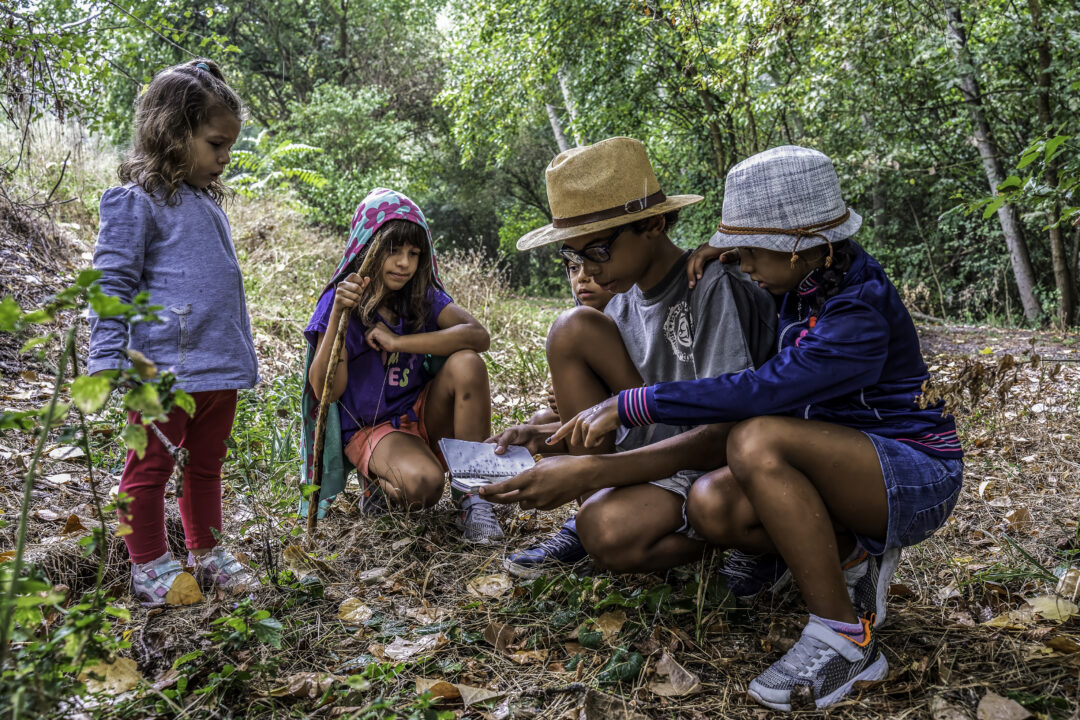How to create meaningful connections and lasting memories through the power of intentional play
Can you hear that? It’s the sound of summer slowly winding down—screen doors closing a little less frequently, the ice cream truck’s melody growing fainter, and those long, lazy days starting to feel numbered. If you’re like most parents and caregivers, you might be feeling a mix of emotions: relief that structure is returning, sadness that these magical days are ending, and maybe a tiny bit of panic about making the most of the time that’s left.
Here’s some wonderful news: you don’t need elaborate plans or expensive adventures to make these final summer days absolutely spectacular for the children in your life. You already have the most powerful tool for connection, healing, and joy right at your fingertips—the incredible magic of play.
What Makes Play So Magical?
Play isn’t just fun and games (though it’s definitely both of those things!). Play is actually a child’s natural language, their way of processing the world, working through emotions, and building the skills they need to thrive. When we join children in their world of play, something beautiful happens—we’re not just entertaining them, we’re actually stepping into their natural healing space.
From a trauma-informed perspective, play serves as a safe laboratory where children can explore feelings, practice new responses, and experience mastery in a way that feels completely natural to them. Unlike adults, who often process experiences through talking, children work through their world through play. It’s where they make sense of complex emotions, build resilience, and—most importantly—experience the deep sense of belonging that comes from being truly seen and understood.
Understanding Play Therapy (And Why You’re Already Qualified!)
Play therapy is a specialized form of therapy that uses play as the primary way to help children express themselves, process experiences, and develop healthy coping skills. Professional play therapists receive extensive training to guide children through therapeutic play experiences. But here’s the beautiful secret: the healing power of play doesn’t require a degree or a therapy office. It requires presence, patience, and a willingness to enter your child’s world with genuine curiosity and joy.
When we engage in what we might call “therapeutic play” at home, we’re creating opportunities for:
🌟 Emotional expression: Play gives children a safe way to show feelings they might not have words for
🌟 Mastery and confidence: Through play, children can be the heroes of their own stories
🌟 Connection and trust: Shared play experiences build deep bonds between children and their grown-ups
🌟 Processing and healing: Play helps children work through difficult experiences in their own time and way
🌟 Building resilience: Through play, children practice bouncing back from challenges and trying new approaches
The Secret Ingredients of Healing Play
The most powerful play experiences aren’t about having the fanciest toys or the most creative activities. They’re about how you show up. Here are the magical ingredients that transform ordinary play into extraordinary connection:
Follow Their Lead (And Watch the Magic Unfold)
Children are the directors of their own play stories. Your job isn’t to teach or guide—it’s to join their adventure with genuine curiosity. When your 4-year-old wants to have a tea party where all the stuffed animals are superheroes, don’t correct the logic. Instead, ask what superpower the teddy bear has and marvel at their creativity.
Become a Feelings Detective
Play gives children permission to express emotions that might feel too big or scary in real life. When the dolls are arguing or the action figures are scared, don’t rush to fix the problem. Instead, become curious: “It seems like that character is feeling upset. I wonder what they need right now?” This helps children explore emotions safely while feeling supported.
Celebrate Their Inner Director
In play, children get to be in charge—and this is incredibly healing, especially for children who may feel powerless in other areas of their lives. Let them decide the rules, change the story midway through, and create worlds that make perfect sense to them (even if they seem wonderfully chaotic to you).
Create a Judgment-Free Zone
The most healing play happens when children feel completely accepted. This means no correcting their storylines, no insisting on “realistic” play, and no rushing to teach lessons. Just pure acceptance of their imagination and creativity.
Summer’s Final Act: Ideas for Intentional Play Adventures
These last weeks of summer are perfect for creating play experiences that build belonging, process the year’s experiences, and prepare hearts for new adventures ahead. Here are some ideas to inspire your own family’s play adventures:
Memory Makers Theater
Transform your living room into a theater where your family can act out favorite summer memories. Let children direct scenes from the best moments of the season—that amazing day at the beach, the night you caught fireflies, the morning you made pancakes together. This isn’t just nostalgia; it’s helping children integrate positive experiences and feel proud of their summer story.
Trauma-informed twist: If this summer had difficult moments, let children include those in their “plays” too. Sometimes the character (them) can try different responses or endings, helping them feel more empowered about challenging experiences.
Feeling Adventures Treasure Hunt
Create treasure hunts where children search for items that represent different emotions—something soft for comfort, something strong for courage, something colorful for joy. Then use these “feeling treasures” to tell stories or create art together.
Why this works: Children learn to identify and name emotions while experiencing the satisfaction of discovery and mastery.
Superhero Training Academy
Set up obstacle courses, creative challenges, and “missions” where children can practice being heroes. Maybe today’s mission is helping a stuffed animal who’s scared about starting school, or creating a potion that helps someone feel brave.
The magic here: Children practice problem-solving and helping others while building confidence in their own abilities to handle challenges.
Time Travel Family Adventures
Use cardboard boxes, blankets, and imagination to “travel” to different times and places. Visit the dinosaurs, explore ancient castles, or journey to the future. Let children lead these adventures and solve whatever challenges arise.
Healing element: When children control time and space in play, they practice feeling powerful and capable, which builds resilience for real-world challenges.
Emotion Color Laboratory
Set up art stations where children can explore what different feelings look like. What color is excitement? How do you draw worry? What does belonging feel like when you sculpt it with Play-Doh?
Beautiful benefit: This helps children develop emotional vocabulary while processing feelings through creative expression.
Creating Belonging Through Shared Play
One of the most powerful gifts we can give children through play is an unshakeable sense of belonging—the deep knowledge that they are seen, valued, and cherished for exactly who they are. Here’s how to weave belonging into every play experience:
Make Room for Their Whole Self
Accept all the parts of your child that show up in play—the silly parts, the serious parts, the parts that might seem “too much” or “too little.” When a child feels accepted in play, they learn they belong just as they are.
Create Family Play Traditions
Establish simple rituals that become “your family’s thing”—maybe it’s Thursday afternoon building challenges, or bedtime story improvisation, or weekend dance parties in the kitchen. These traditions create a sense of “this is where I belong.”
Tell Their Story Back to Them
Throughout play, reflect back what you notice: “You’re such a creative problem-solver!” “I love how kind your character is to everyone.” “You have such interesting ideas!” This helps children see themselves through loving eyes.
Include Their Ideas in Family Life
When children create something amazing in play—a new game, a funny character, a creative solution—find ways to incorporate these into your regular family life. This shows that their contributions matter and have lasting value.
When Play Gets Complicated (And That’s Okay Too)
Sometimes children use play to work through difficult or confusing experiences. You might see themes of loss, fear, anger, or sadness emerge in their play. This is actually a sign that play is doing its healing work, but it can feel scary for grown-ups who want to protect children from pain.
Here’s how to support children when play touches on difficult themes:
- Stay present and calm: Your peaceful presence helps children feel safe to explore difficult emotions.
- Don’t rush to fix: Resist the urge to immediately make the play “happier.” Let children work through whatever they need to process.
- Follow their lead: Let children decide how much to explore and when they’re ready to move on to different themes.
- Validate their experience: “That seems really important to you” or “I can see you’re thinking hard about this.”
- Know when to seek support: If you notice concerning themes or behaviors in play, consider connecting with a professional play therapist who can provide additional guidance.
Making the Ordinary Extraordinary
The most healing play doesn’t require special equipment or elaborate setups. It requires your presence, your curiosity, and your willingness to see the world through your child’s eyes. These final summer days can be transformed into healing adventures with simple additions:
- Turn cleanup into a game: “Let’s see if these toys can find their way home before the music stops!”
- Make meals into storytelling: “What adventure did this carrot go on before it got to our plate?”
- Transform bath time: Add food coloring, floating toys, or cups for pouring to create underwater worlds
- Create bedtime stories together: Take turns adding sentences to make up completely new adventures
- Dance out emotions: Put on different types of music and move your bodies to show how different feelings feel
The Gift That Keeps Growing
When you invest time in intentional play with children, you’re not just filling summer days—you’re building a foundation that will serve them throughout their lives. Children who experience healing play learn that:
- Their emotions are valid and manageable
- They have the power to solve problems and overcome challenges
- They belong and are valued exactly as they are
- The adults in their lives are safe, fun, and trustworthy
- They have unique gifts and perspectives worth sharing
- Play and joy are always available, even during difficult times
Your Summer Play Legacy
As these final summer days unfold, remember that you don’t need to be perfect or have endless energy. You just need to show up with curiosity and love. Some days, healing play might be an elaborate adventure. Other days, it might be five minutes of silly faces while folding laundry together.
What matters most is that children feel seen, heard, and valued in these shared moments of joy. When summer fades into memory, these experiences of belonging and connection will remain, woven into the fabric of who your child is becoming.
The magic isn’t in the activities themselves—it’s in the message you send when you choose to enter your child’s world with genuine interest and delight. You’re saying: “You matter. Your ideas matter. Your feelings matter. You belong here with me, exactly as you are.”
And really, isn’t that the most beautiful gift any of us could hope to receive?



